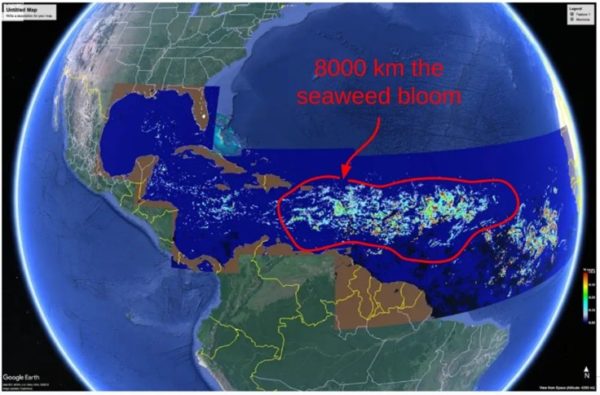Sargassum Is Coming to Cuba, What Does That Mean?

The influx of sargassum seaweed is not a new problem for Cuba. In 2018, the country was hit hard by a massive bloom of seaweed.
By S.E. Lewinski
HAVANA TIMES – In the last few years, Cuba has faced an exodus of people, the plague of a pandemic, food shortages, fires from oil tank explosions, floods from hurricanes, severe inflation…STOP! This sounds almost biblical as a message to let the people be free. No matter how mighty the government enforces its will, the world is fighting back. The next hailing being sent is the massive Sargassum seaweed bloom crossing the Atlantic and arriving soon to the coasts of the island. The seaweed extends to a massive 8000 kilometers long that will impact Cuba, the Caribbean, and the United States.
Sargassum seaweed has been causing problems around the world for several years now. This brown seaweed is native to the Sargasso Sea, a region of the Atlantic Ocean between Bermuda, the Bahamas, and the East Coast of the United States. However, in recent years, massive quantities of sargassum seaweed have been washing up on the shores of various countries in the Caribbean, including Mexico, the Dominican Republic, and Jamaica. The latest country to be threatened by this phenomenon is Cuba, which is facing the risk of significant environmental and economic damage as the seaweed continues to arrive on its shores.
The influx of sargassum seaweed is not a new problem for Cuba. In 2018, the country was hit hard by a massive bloom of seaweed, which affected over 600 kilometers of coastline. The seaweed caused significant damage to the island’s tourist industry, which is a vital source of revenue for the country. The seaweed can make swimming and water activities difficult, and the strong smell can be unpleasant (Hydrogen Sulfide Gas) for tourists. In addition to the tourism industry, sargassum seaweed can also affect the fishing industry, as the seaweed can damage fishing equipment and harm fish populations.
There are several reasons why sargassum seaweed has been appearing in such large quantities in the Caribbean in recent years. One possible cause is climate change, which can affect ocean currents and water temperature, leading to changes in the distribution and growth of seaweed. Another possible cause is the increased nutrient levels in the ocean, which can result from fertilizer runoff from agricultural activities and sewage discharge from cities.
The problem of sargassum seaweed is not easy to solve. Cleaning up the seaweed is a difficult and expensive process, and it can be challenging to prevent it from washing up on the shore in the first place.

“The problems with sargassum arise when it hits the beaches, piling up in mounds that can be difficult to navigate and emitting a gas that can smell like rotten eggs. Sargassum can also quickly turn from an asset to a threat to ocean life. It comes in such “large quantities that it basically sucks the oxygen out of the water and creates what we refer to as dead zones,” Lapointe said. These are normally nursery habitats for fisheries … and once they’re devoid of oxygen, we have lost that habitat.” Sargassum can be dangerous to humans, too, Lapointe added. The gas emitted from the rotting algae — hydrogen sulfide — is toxic and can cause respiratory problems. The seaweed also contains arsenic in its flesh, making it dangerous if ingested or used for fertilizer.” Space and Science
In conclusion, the arrival of sargassum seaweed on the shores of Cuba is a significant threat to the country’s environment and economy. While there is no easy solution to this problem, it is essential that the government and the international community work together to develop strategies to prevent and mitigate the impact of seaweed. Failure to address this issue could have long-lasting and severe consequences for Cuba’s tourism and fishing industries, as well as for the environment and the health of its citizens.
Warnings to Cuba:
Do not use seaweed for fertilizer due to arsenic contents that can harm people and also leach into the groundwater. Proper disposal is important to protect the land and people.
No one should attempt to leave the island by boat during this crisis with the potential difficulty to navigate and the toxicity of the seaweed bloom.





